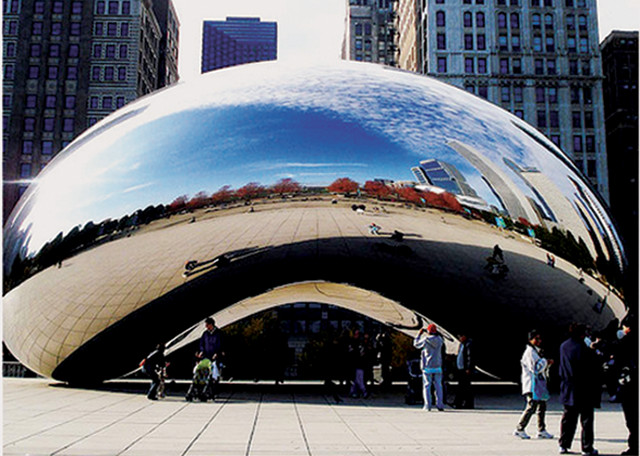
by U.S. Geological Survey Wednesday, June 13, 2018
Peter H. Kuck, a mineral commodity specialist for the U.S. Geological Survey, compiled the following information on nickel, a metal that is an important component of stainless steel and superalloys.
People have mined nickel-rich ores for more than 2,300 years. The ores were first used to produce an alloy that ancient Chinese artisans called “pai-t’ung.” This alloy, known today as “white copper,” is typically composed of 70 percent copper, 20 percent nickel and 10 percent zinc. Cupronickel alloys were used in coins as early as 235 B.C. and still are today. However, it was not until 1751 that Axel Fredrik Cronstedt identified nickel as a unique chemical element.

The Cloud Gate sculpture in Chicago's Millennium Park is a popular meeting place for locals, who have dubbed it the "mercury bean" for its shape and the liquid-metal appearance of its surface, which is formed of mirror-finished stainless steel containing 12 percent nickel. Credit: Courtesy of the Nickel Institute/photo by Tom Ready
Nickel became more widely used following the American Civil War when there was rapid development of nickel steels for naval armor plate and ordnance. Growing military demand for nickel steels, which were more resistant to corrosion and oxidation, led to development of nickel mines in New Caledonia, which started exporting lateritic nickel ore in 1875. In 1886, the Canadian Copper Company began mining nickel sulfide ore from newly discovered deposits in the Sudbury district of Ontario; by 1930, Sudbury was the nickel capital of the world. Today, these two types of ore are still the main sources of mined nickel. In 1913, Harry Brearley, a British metallurgist, revolutionized the cutlery industry when he discovered that a steel containing 12.8 percent chromium strongly resisted chemical attack. A year later, researchers in Germany found that the addition of nickel to chromium steel increased its ductility and resistance to acids. By 1930, kitchen sinks, cutlery and other kitchen utensils were being fabricated from austenitic (nickel-bearing) stainless steel — a generic term for a group of corrosion-resistant steels containing at least 10.5 percent chromium. Today, austenitic stainless steel accounts for more than 60 percent of global nickel consumption.
Shortly before World War II, a new family of heat-resistant alloys, known today as “superalloys,” was developed for use above 540 degrees Celsius. Their base-alloying element is usually nickel, cobalt or nickel-iron. Nickel-based superalloys are used in engines of jet aircraft, piping for geothermal wells, and the gas and steam turbines that are used to generate most of the world’s electricity.
For the near future, stainless steel is expected to remain the principal end use for nickel. However, there is a growing market for nickel in both the battery and superalloy sectors. Rechargeable nickel-cadmium batteries have proven useful for starting aircraft engines and storing energy generated by renewable energy sources. The nickel-metal hydride battery, invented in 1967, has replaced nickel-cadmium batteries in several important applications, including in hybrid electric vehicles.
For more information on nickel and other mineral resources, visit: minerals.usgs.gov/minerals.
Nickel Production and Consumption:
In 2011, world mine production of nickel was 1.94 million metric tons.
Indonesia, the Philippines and Russia were the leading producers of nickel ores and concentrates in 2011, with 14 percent of global mine output each, followed by Australia and Canada, with 11 percent share each.
The recycling of stainless steel scrap and superalloy scrap has become a significant source of nickel supply. In 2011, the United States consumed 89,300 metric tons of nickel contained in scrap compared with 103,000 metric tons of primary nickel.
Fun Facts:
One of the first uses of nickel in the United States was the minting of the Flying Eagle cent from 1856 to 1858; it contained 88 percent copper and 12 percent nickel.
The Jefferson nickel is actually a cupronickel alloy containing only 25 percent nickel.
Although pure nickel is magnetic, austenitic stainless steels are not.
There are about 3,000 nickel-containing alloys in everyday use.
© 2008-2021. All rights reserved. Any copying, redistribution or retransmission of any of the contents of this service without the expressed written permission of the American Geosciences Institute is expressly prohibited. Click here for all copyright requests.